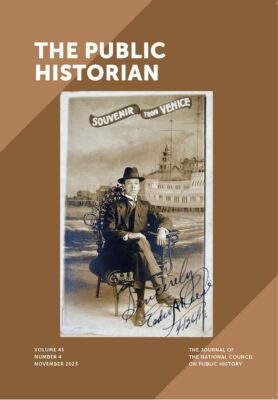Editor’s Corner: Digital Archives, School Names, and Visionary Founders
01 November 2023 – Sarah H. Case
 Editors’ Note: We publish the editor’s introduction to the November 2023 issue of The Public Historian here. The entire issue is available online to National Council on Public History members and to others with subscription access.
Editors’ Note: We publish the editor’s introduction to the November 2023 issue of The Public Historian here. The entire issue is available online to National Council on Public History members and to others with subscription access.
This issue features five reports from the field, analyzing diverse and far-reaching projects. Reflecting current trends, three discuss digital archives and propose models to help establish best practices for the medium. The first, “Slow Disasters and Adaptive Archiving: COVID-19 and the Rolling-Response Model,” by Kathleen Kole de Peralta and Marissa Rhodes examines the creation of A Journal of the Plague Year: A COVID-19 Archive (JOTPY). Originally conceived as a short-term, rapid-response archive to collect during what was assumed to be a brief period of lockdown, it evolved into an expansive, international, and ongoing project. Kole de Peralta and Rhodes coined the term “rolling-response archive” to describe the kind of collecting that the pandemic necessitated; that is, “an archive that collects stories over a long period (six months or more) and adjusts its collection and curatorial practices in response to the lived historical moment.” Characterized by “crowdsourced material, extended data collection, real-time curation, and self-reflexivity,” the rolling-response model offers a way to document other long-term social disruptions.
Eric L. Milenkiewicz, in “Increasing Access to American Indian Off-Reservation Boarding School Archives: Sherman Indian Museum Digital Project,” also describes an innovative digital archival project. As he writes, the depth of the legacy of cultural violence of American Indian schools have been obscured in “limited and scattered histories” which fail to analyze “the lived experience of the students and campus community.” The Sherman Indian Museum has collaborated with the University of California, Riverside to process, digitize, and make public their extensive archival holdings related to boarding schools. Key to the success of the project is the cross-institutional collaboration. The digital archive utilized the Protocols for Native American Archival Materials (PNAAM), which provided, among other things, guidance as to how to balance conflicting needs of increasing knowledge about and access to materials with the need to restrict materials particularly sensitive within the Indigenous context.
Athena Syriatou, Elias Stouraitis, and Kyriakos Sgouropoulos offer our third report from the field focused on digital archiving in “History, Historical Culture, and 1821: Creating a Digital Archive of Public History in the Twenty-First Century.” The authors document the creation of the 1821 Greek Revolution Observatory, focused on the bicentenary of the Greek revolution, a key moment in the creation of the modern nation. The project sought to collect broadly “historical culture,” defined as “a concept that includes both academic and public connections to the past via ceremonies, memory, emotions, materiality.” To that end, it included works by academic historians together with community-based histories and presented them as in conversation with each other rather than as completely discreet phenomena.
Although inspired by a Facebook post, “We and Bobby Lee: Public Historians and the Fight to Remove Confederate Memorials,” by Jason Pierce and Michael Powers, reorients our focus from the digital and to the world of school board meetings and local politics. The two authors ask, “What is the role of the professional historian in local debates—contentious school board meetings in particular—that hinge on misconceptions of the American past?” Members of their local community, San Angelo, Texas, organized to change the name of Robert E. Lee Middle School, questioning the appropriateness of celebrating the Confederate general. Realizing that they could contribute to the conversation because of their historical training and knowledge, and their access to university resources, the two authors participated as active allies to the successful movement to change the name of the school. Although academically trained historians, they are also community members (and one is a parent of students at the school), and they conclude, “our participation in the movement contributed to our belief in the necessity of historians participating in public discourse and social movements in important and strategic ways.”
Our final article, Trevor Anthony’s “Busy Being Born: A Brief History of the Museum of Pop Culture,” explores the development and trajectory of Seattle’s the Museum of Pop Culture (MoPOP), created by Microsoft co-founder Paul Allen. Originally founded as the Experience Music Project (EMP) in 2000, it began looking beyond music and became MoPOP in 2016. Acknowledging some of the problems with sustainability faced by the museum, Anthony looks at the role of the “visionary” with appreciation, noting that sometimes “collectives can conform rather than create.” He argues for considering how the museum makes pop culture historically meaningful by “elevat[ing] the power of the personal and the nostalgic in producing the collective phenomenon that we call history.” Together these reports consider new kinds of public history engagement and opportunities.
~Sarah H. Case, the editor of The Public Historian, earned her MA and Ph.D. in history at the University of California, Santa Barbara, where she is a continuing lecturer in history, teaching courses in public history, women’s history, and history of the South. She is the author of Leaders of Their Race: Educating Black and White Women in the New South (Illinois, 2017) and articles on women and education, reform, and commemoration.



